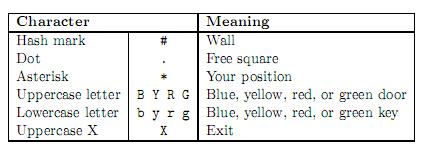
1 10 *........X 1 3 *#X 3 20 #################### #XY.gBr.*.Rb.G.GG.y# #################### 0 0
Escape possible in 9 steps. The poor student is trapped! Escape possible in 45 steps.
每个格子都有不同的状态,关键是在判断在走到当前格子的当前key状态是否走过。
#include<stdio.h>
#include<queue>
#include<iostream>
#include<string.h>
using namespace std;
#define N 105
struct locate
{
int x,y,step,state;
};
char map[N][N];
int state[N][N][16],n,m;
int BFS(int sx,int sy)
{
queue<locate>q;
locate p,tp;
int dir[4][2]={0,1,1,0,0,-1,-1,0};
char door[6]={"BYRG"},key[6]={"byrg"};
memset(state,0,sizeof(state));
p.step=0; p.state=0;
p.x=sx; p.y=sy;
q.push(p); state[sx][sy][0]=1;
while(!q.empty())
{
p=q.front(); q.pop();
for(int e = 0;e < 4;++e)
{
tp.x=p.x+dir[e][0];
tp.y=p.y+dir[e][1];
if(tp.x>=0&&tp.x<n&&tp.y>=0&&tp.y<m&&map[tp.x][tp.y]!='#'&&!state[tp.x][tp.y][p.state])
{
tp.step=p.step+1;
tp.state=p.state;
if(map[tp.x][tp.y]=='X')
return tp.step;
int flag=0;
for(int i=0;i<4;i++)
if(map[tp.x][tp.y]==key[i])
{
flag=1; tp.state|=(1<<i);break;
}
state[tp.x][tp.y][tp.state]=1;
if(!flag)
{
flag=0;
for(int i=0;i<4;i++)
if(map[tp.x][tp.y]==door[i])
{
flag=1;
if(tp.state&(1<<i))
flag=2;
break;
}
if(flag!=1)
q.push(tp);
}
else
q.push(tp);
}
}
}
return 0;
}
int main()
{
int sx,sy;
while(scanf("%d%d",&n,&m)>0)
{
if(n==0&&m==0)
break;
for(int i=0;i<n;i++)
scanf("%s",map[i]);
for(int i=0;i<n;i++)
for(int j=0;j<m;j++)
if(map[i][j]=='*')
sx=i,sy=j;
int ans=BFS(sx,sy);
if(ans)
printf("Escape possible in %d steps.\n",ans);
else
printf("The poor student is trapped!\n");
}
}
1885Key Task(BFS+状态压缩)(胜利大逃亡续)一个意思
原文地址:http://blog.csdn.net/u010372095/article/details/41523199